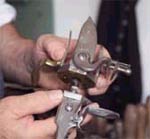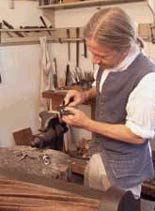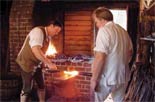The Gunsmith's Shop
Text by Ed Crews
Photos by Dave Doody

A customer, in the person of interpreter Ron Carnegie, considers a purchase from the Colonial Williamsburg shop of journeyman gunsmith George Suiter.
Gunsmith George Suiter leans over his workbench, engrossed in intricate metal work. Bright sunlight pours in a large window, and he sees clearly the parts he is fitting together. He has more than thirty years of gun-making experience, but this is unexplored territory. Suiter is reproducing an eighteenth-century swivel gun.
Used by wealthy Europeans, swivel guns had two barrels, set one atop the other. One barrel has a smooth interior and fires pellets for hunting birds and other small game. The second barrel is rifled, which means it has spiraled grooves cut into its interior. The grooves make the bullet spin as it heads toward a target, which increases range, stability, and accuracy. This barrel is for big game.
The swivel gun's design allowed a 1700s hunter to rotate barrels to choose the best ammunition for his target. To make that choice, a marksman flipped a metal tab to unlock the barrels. He turned the appropriate barrel to the top, locked it in place with another flip of the tab, and fired.
"This is the first time we've made a swivel gun," said Suiter, the Colonial Williamsburg gun shop's senior journeyman and supervisor. "I learned a lot in the process. Probably, the most important thing I've learned is that precision work is possible with hand-tool technology. For example, using equipment we have here, I've been able to ream the barrels so their interior diameters differ by only 0.0005 of an inch."

The swivel-gun mechanism.
Projects like the swivel gun always are under way in the small Historic Area shop between the Capitol and Francis Street. Another gunsmith is reproducing a long-rifle used by frontier hunters and Indian fighters. A third is making an elegant copy of a boy's fowling piece, a hunting weapon scaled-down so that a ten-year old could use it easily and comfortably. Rich in detail and silver highlights, it was something only a wealthy plantation owner's son could have had.
These craftsmen, and their predecessors, have tackled hundreds of similar projects since Colonial Williamsburg's gunsmithing program began in 1963. It combines their production talents with a mission to educate visitors. Wallace Gusler, master of the gun shop, has been essential from the start. He arrived in 1962 to get the operation going. He was twenty then. A self-taught gunsmith from Southwest Virginia, he had built his first muzzleloader, a pistol, six years before without instruction.
"I grew up hunting and fishing," Gusler said. "I also was interested in Indian artifacts and the history of the Virginia frontier during the French and Indian War. My father had a percussion, muzzle-loading rifle made about 1830. One day, I started cleaning it and got intrigued with how it worked. This led me to make my first pistol. I tried to copy one I had seen in Antiques Magazine. I made the firing mechanism, figuring out how to build it by disassembling my father's rifle. I made parts and salvaged some springs from a Model T. The pistol worked, and I even used it for squirrel hunting."
Gusler's interest became a passion. To learn more, he talked with local gunsmiths, read, and began repairing antique weapons. He connected with a growing network of firearms enthusiasts interested in shooting and collecting old American weapons. Impressed, Gusler's high school principal and shop teacher allowed him to build a reproduction of a nineteenth-century rifle in shop class. "At that point in my life, gunsmithing became an obsession," he said.
Through friends interested in antique guns, Gusler learned of Colonial Williamsburg's hope to open a shop and its need for a gunsmith. He applied on the strength of his knowledge and his talents as demonstrated by the high-school rifle. "The gun I made in high school was the one that got me the job in Colonial Williamsburg."
From the outset, Colonial Williamsburg's gunsmithing program has been dedicated to preserving the craft and expanding the knowledge of it. Master Blacksmith John Allgood and Gusler worked together, accumulating tools, information, and skills during the 1960s. In 1965, Gusler made Colonial Williamsburg's first hand-forged barrel. It was a difficult, time-consuming operation. He soon understood the words of an old gunsmith who had told him that the process required "a big fire and three crazy men."

Journeyman gunsmith Richar Frazier words on a lock at a bench vise.
The shop also made a boring machine and a rifling machine to groove the barrels. That year, Gusler used them to construct his first rifle fabricated entirely of hand-made parts. It established the shop and launched its program.
Two gunsmiths have become a staff of six: Gusler and Suiter; Richard Frazier, journeyman; Clay Smith, journeyman; Jeff Geyer, apprentice; and Byron Smith, interpreter. Everybody is familiar with eighteenth-century firearms technology.
Overwhelmingly, civilian and military weapons of the period in Europe and America were flintlocks. The name refers to the ignition system, which relied on a piece of flint set in a movable cock. The cock fell when the trigger was pulled. The flint struck a piece of steel, creating sparks. The sparks fell into a gunpowder charge in an external pan. The powder ignited the main charge in the barrel by passing through a small hole in the barrel.
In 1700s Virginia, the flintlock system was used on all military muskets, which were smoothbores, and on civilian arms, which included fowling pieces, trade guns, and rifles.
The fowling piece probably was the most popular civilian arm of the day. Men liked them for their versatility. Hunters could load them with small lead balls for birds and other small game. They also could use a single large ball or several smaller ones-buckshot-for large game like deer. The long fowler was a variation of the fowling piece. It was heavy and big, and designed to kill as many waterfowl in a shot as possible.
The trade gun was a smoothbore. It was a simple, inexpensive piece made in Europe for use in America.
The rifle was, in comparison to fowling pieces and smoothbores, highly accurate at long distances, and well suited to the frontier.
"To be an accomplished gun maker can require knowledge about working with a variety of materials: iron, steel, brass, silver, and wood," Gusler said. "You need to know a little bit about the skills required by a carver, engraver, machinist, blacksmith, silversmith, and tool maker, although you don't need mastery in all. The mix is intriguing and demanding."
The mix reflects the complexity of firearms. Consider the three major components of all guns in this period:
Firelock, or lock. This was the firing mechanism. It included a trigger, an external powder pan, a hammer, springs, and other small internal parts. Making the lock required mechanical skill and steady hands. Each part, every screw, was handmade and required forging, filing, and fitting.
Stock. This was the wooden part of the weapon. It held the barrel and firing mechanism, and allowed a shooter to grip and to steady the weapon. Stock makers of the 1700s used well-seasoned hardwoods like curly maple. The stock could be plain or ornately carved. The firelock and the barrel had to be carefully fitted into the stock. Stock making required woodworking skills of a high order.
Barrel. The barrel was the long tube through which the bullet passed. Barrel makers began work with a flat wrought-iron bar. This was forged into a tube by heating, hammering, and fusing with flux. The tube was bored with a reamer for a uniform interior. The barrel was tested, or proofed. That involved firing the barrel with four times the normal amount of gunpowder. This was done at stationary stand, and barrel testers used a fuse to clear the area. If the barrel could withstand this without exploding, it was ready to use.
Colonial Williamsburg gunsmiths can perform all the work required, but most eighteenth-century guns were not made by a single man producing all the components for a single weapon. Most guns in North America came from Europe where they were assembled from parts built by subcontractors who spent their lifetimes making one or two parts, such as barrels or triggers. This approach allowed European gun makers to keep production steady and costs low through economies of scale and the division of labor. This manufacturing system, particularly in Great Britain, reflected the evolution from a rural to an urban society. It also was the beginning of interchangeable parts and assembly line production which characterized the Industrial Revolution.

A barrel takes shape on an anvil beside the forge under the hammer of journeyman gunsmith Clay Smith with Suiter's help.
"There was an agricultural revolution in England during the 1700s. The market for wool was strong. So, sheep production grew. It was more economical to move people off farmland and use it for sheep," Suiter said. "These displaced people went to cities, where they formed a pool of cheap labor. There, they also picked up work skills and could specialize in specific tasks for various producers. This trend had an impact on gun making, which needed many components. In London, during the 1740s, twenty-one trades were involved in gun production."
Many subcontractor gun parts were produced in cottage industry settings. One part of a home, for example, might be used exclusively for making springs used in firing mechanisms. In the end, all parts were sent to a central facility where complete weapons were assembled. Small parts makers tended to live close to gun assembly shops, creating vibrant and economically close-knit communities.
American gun makers could not compete with the efficiency or scale of this system. Colonial gunsmiths typically did repairs rather than production. They often took on non-gun related tasks, applying their blacksmithing and mechanical skills to whatever job came along. In peacetime, this seemed to be the case in eighteenth-century Williamsburg. The Geddy family was perhaps the best-known of all the city's gunsmiths then. Among the other gunsmiths were William Willis and John Brush.
Colonial gunmakers, however, could and did control one niche in the North American market. That was rifle making. "The long rifle was the only gun made in numbers in America in the 1700s," Gusler said. "During its time, it was the highest expression of the gun maker's art in this country."
The long rifle apparently evolved from German hunting rifles; the gunsmiths who created this New World weapon initially shared a German heritage. The American long rifle grew from these roots to meet frontier needs and conditions. The conventional wisdom has been that these rifles were made exclusively in Kentucky and Pennsylvania. Gusler's research, conducted over his lifetime, shows, however, that long rifles were also made in Virginia, especially around Shepherdstown, Winchester, Augusta County, and the central Shenandoah Valley.
The long rifle was the weapon for the frontier. Its long range allowed hunters to take large game, such as deer and elk, at a distance. A marksman could hit targets at two hundred yards. Powder and shot were short on the frontier, and long rifles let hunters get food with one round, reducing the ammunition they needed to buy and to carry.
Because of the long rifle's handsome appearance and its reputation as an especially American tool, modern day Williamsburg gunsmiths regularly make them for enthusiasts. The waiting list is long, about four years, and the price for a weapon is high, averaging $20,000.

Apprentice gunsmith Jeff Geyer uses a candle to supplement sunlight from the windows to work on a flintlock's stock.
Not only are gun making and gun history important to today's Colonial Williamsburg smiths, so is helping visitors understand the role of the gun in early American history.
Many Americans have never held or fired a pistol or a rifle and lack knowledge of their functioning and capabilities. In the 1960s, when Gusler started, and into the 1970s, this wasn't the case. Many visitors had grown up on farms and used guns for hunting and recreation. In addition, veterans of World War II, the Korean Conflict, and Vietnam had learned to use rifles in basic training. But shifts from rural areas to urban areas, and a decline in the veteran population and military service has changed this. Moreover, concerns about guns and crime have inspired emotions about weapons ranging from fear to anger-all of which gun shop personnel have seen firsthand.
When Suiter came to Colonial Williamsburg about twenty-five years ago, many gun shop visitors questions dealt with technical issues about gun performance and production. Fewer of these questions are asked today. Instead, people want to understand the social history of the gun in America and the evolution of the Second Amendment.
Gun shop staff say that tackling these issues and bridging the knowledge gap is made easier by interpretative themes in the restored area. This year's theme-"Taking Possession"-is a perfect vehicle.
Focusing on "Taking Possession," which addresses exploration, expansion, and settlement of colonial America, Suiter likes to explain how important a role the gun played in frontier life. What was then the West teemed with big game. Firearms allowed settlers to take it with comparative ease, ensuring their survival as well as that of their family, and their community.
Guns also had an impact on the colonial economies. At certain points in the 1700s, deer-hide shipments to Europe were a large and crucial part of Virginia's commerce.
Finally, Suiter said, guns, particularly rifles, helped settlers defend themselves. Armed frontiersmen could fight and overpower Native Americans using superior weapons technology.
Gusler and Suiter believe that talking about the role of guns in colonial America will help people to understand perceptions of them today. Perhaps as important is the shop's preservation of the gunsmith's art, rapidly vanishing in the industrialized age.
"We want to preserve the trade so we can pass it on," Suiter said. "Preservation, for us, means practice. We look on each gun we make as a research project. All of them give us a chance to learn and to expand our skills."
Richmond writer Ed Crews contributed to the summer journal "A Bad Girl Goes Good in Early Virginia," an article about eighteenth-century novelist Daniel Defoe's Moll Flanders.
